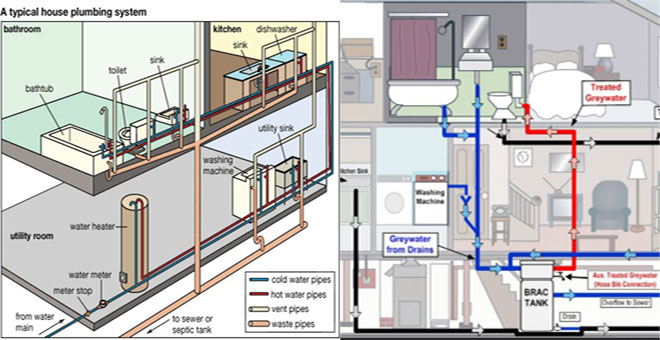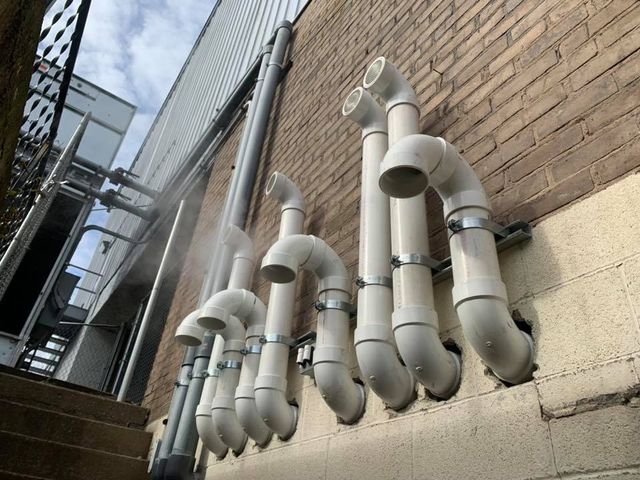Anatomy of Your House's Plumbing System: How It Matters
Anatomy of Your House's Plumbing System: How It Matters
Blog Article
What're your thoughts about Plumbing Installation 101: All You Need to Know?

Recognizing just how your home's pipes system functions is crucial for every single home owner. From delivering clean water for drinking, cooking, and bathing to securely getting rid of wastewater, a properly maintained pipes system is vital for your household's health and convenience. In this extensive guide, we'll discover the detailed network that composes your home's pipes and offer tips on maintenance, upgrades, and handling typical problems.
Introduction
Your home's pipes system is greater than just a network of pipes; it's a complex system that guarantees you have accessibility to clean water and efficient wastewater elimination. Understanding its elements and just how they collaborate can assist you prevent pricey repair services and make sure every little thing runs smoothly.
Basic Elements of a Pipes System
Pipes and Tubes
At the heart of your pipes system are the pipelines and tubes that bring water throughout your home. These can be made from numerous products such as copper, PVC, or PEX, each with its benefits in terms of sturdiness and cost-effectiveness.
Fixtures: Sinks, Toilets, Showers, and so on.
Fixtures like sinks, commodes, showers, and tubs are where water is used in your house. Understanding just how these components link to the plumbing system aids in identifying problems and intending upgrades.
Shutoffs and Shut-off Points
Shutoffs manage the circulation of water in your plumbing system. Shut-off shutoffs are vital during emergency situations or when you require to make repair work, permitting you to separate parts of the system without interrupting water circulation to the whole home.
Water Supply System
Main Water Line
The major water line connects your home to the metropolitan water supply or an exclusive well. It's where water enters your home and is distributed to numerous components.
Water Meter and Pressure Regulator
The water meter actions your water usage, while a stress regulatory authority ensures that water streams at a secure stress throughout your home's plumbing system, protecting against damage to pipelines and components.
Cold Water vs. Warm water Lines
Understanding the distinction between cold water lines, which supply water straight from the main, and warm water lines, which carry heated water from the water heater, helps in repairing and planning for upgrades.
Water drainage System
Drain Pipeline and Traps
Drain pipelines carry wastewater away from sinks, showers, and commodes to the drain or sewage-disposal tank. Traps protect against drain gases from entering your home and likewise catch debris that can cause blockages.
Air flow Pipelines
Ventilation pipes enable air right into the drain system, protecting against suction that could slow drainage and cause catches to empty. Appropriate air flow is vital for keeping the integrity of your plumbing system.
Value of Correct Water Drainage
Making certain correct drainage prevents backups and water damage. On a regular basis cleaning up drains and preserving catches can protect against expensive repair services and expand the life of your plumbing system.
Water Heating Unit
Kinds Of Hot Water Heater
Hot water heater can be tankless or typical tank-style. Tankless heating systems warm water as needed, while containers save warmed water for prompt use.
Upgrading Your Plumbing System
Reasons for Upgrading
Updating to water-efficient components or changing old pipelines can enhance water top quality, decrease water expenses, and raise the value of your home.
Modern Plumbing Technologies and Their Benefits
Check out modern technologies like wise leakage detectors, water-saving commodes, and energy-efficient hot water heater that can conserve cash and decrease environmental effect.
Expense Factors To Consider and ROI
Calculate the in advance expenses versus long-term financial savings when thinking about pipes upgrades. Many upgrades pay for themselves with decreased utility bills and fewer fixings.
Just How Water Heaters Connect to the Pipes System
Comprehending how hot water heater attach to both the cold water supply and hot water distribution lines assists in identifying problems like inadequate warm water or leakages.
Upkeep Tips for Water Heaters
Frequently flushing your water heater to remove sediment, examining the temperature settings, and checking for leaks can extend its life-span and improve power performance.
Typical Plumbing Concerns
Leaks and Their Reasons
Leakages can occur because of aging pipelines, loosened installations, or high water pressure. Addressing leakages immediately avoids water damage and mold and mildew development.
Clogs and Obstructions
Clogs in drains and commodes are usually caused by purging non-flushable products or a buildup of oil and hair. Using drainpipe screens and bearing in mind what decreases your drains pipes can avoid blockages.
Signs of Pipes Issues to Expect
Low water pressure, slow drains, foul odors, or unusually high water expenses are indicators of potential pipes issues that need to be attended to promptly.
Pipes Upkeep Tips
Regular Assessments and Checks
Arrange yearly plumbing examinations to catch issues early. Seek indicators of leaks, deterioration, or mineral buildup in taps and showerheads.
DIY Upkeep Tasks
Straightforward jobs like cleaning tap aerators, looking for bathroom leakages using color tablets, or protecting revealed pipelines in chilly climates can protect against major pipes issues.
When to Call an Expert Plumber
Know when a pipes problem requires specialist knowledge. Trying complicated fixings without appropriate expertise can result in even more damage and greater repair costs.
Tips for Minimizing Water Use
Straightforward practices like repairing leakages without delay, taking shorter showers, and running complete loads of laundry and meals can conserve water and lower your energy bills.
Eco-Friendly Pipes Options
Take into consideration sustainable plumbing materials like bamboo for floor covering, which is durable and environment-friendly, or recycled glass for countertops.
Emergency situation Readiness
Actions to Take During a Plumbing Emergency
Know where your shut-off shutoffs lie and just how to switch off the water in case of a ruptured pipe or significant leakage.
Relevance of Having Emergency Situation Contacts Handy
Keep contact information for local plumbers or emergency situation solutions readily available for quick feedback during a plumbing dilemma.
Ecological Influence and Preservation
Water-Saving Components and Home Appliances
Mounting low-flow taps, showerheads, and commodes can significantly lower water usage without compromising efficiency.
DIY Emergency Fixes (When Appropriate).
Short-term solutions like utilizing duct tape to patch a dripping pipe or positioning a container under a trickling tap can minimize damage till a specialist plumbing shows up.
Conclusion.
Understanding the makeup of your home's pipes system equips you to preserve it efficiently, saving time and money on fixings. By following normal maintenance regimens and remaining notified regarding modern plumbing modern technologies, you can guarantee your plumbing system operates efficiently for years to come.
Understanding Your Home Plumbing System: A Comprehensive Guide
Plumbing System: The Lifeline of Your Home
At its core, the plumbing system is designed to perform two primary functions: bring fresh water into your home and remove wastewater. The system is a network of pipes, fixtures, and other components that transport water and sewage. Residential plumbing systems include potable water supply lines, drain-waste-vent (DWV) systems, and various plumbing fixtures that make water use in daily tasks possible.
Key Components:
Water Supply: This part of your plumbing system brings municipal water into your home, passing through the main water supply line. It s responsible for supplying all water needs, from drinking to bathing.
Drainage System: It carries waste and water away from your home to the sewer or septic system. This system includes all the piping within your home that leads to external sewage or septic systems.
Vent System: An essential yet often overlooked component, the vent system allows sewer gases to escape and lets air into the drainpipes, ensuring water and waste move correctly through the system.
Fixture: More Than Just Taps and Toilets
Plumbing fixtures are the most interactive parts of the plumbing system, including faucets, showers, toilets, and sinks. Each fixture is connected to the plumbing system and plays a role in either the delivery of freshwater or the disposal of waste and wastewater.
Types of Fixtures:
Faucets and Sinks: Used for washing hands, dishes, and other daily water needs. Toilets: Dispose of human waste through the sewage system. Bathtubs and Showers: Provide bathing facilities, requiring both hot and cold water supply. Water Supply: The Source of Life
The water supply system is a critical component, ensuring that potable water is available throughout your home for various uses, including drinking, cooking, and cleaning. This system consists of pipes that distribute water to different parts of the house, controlled by valves to regulate the water flow.
Types of Plumbing: Materials and Methods
Various types of plumbing systems and materials are used in residential settings, each with its advantages and applications. From copper and PVC pipes for water supply to cast iron and ABS for drainage, the choice of materials can impact the longevity and efficiency of your plumbing system.
https://intownplumbingtx.com/articles/home-plumbing-system-guide/

I hope you enjoyed reading our post about The Inner Workings of Your Home's Plumbing. Thanks for spending some time to read our piece of content. Remember to take the opportunity to share this blog entry if you liked it. We thank you for reading our article about Understanding Your Home's Plumbing Anatomy.
Hire A Pro Report this page